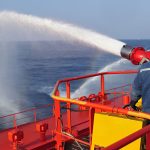Fire is one of the most common and dangerous emergency onboard ship which has lead to disastrous results including loss of property and life. As the resources available onboard to fight fire are limited, preventive measures are more effective than fire fighting measures. For this reason, an international safety system was laid down by regulating authorities to make a ship fully prepared for fighting any kind of fire.
The Safety system on chapter II-2 of SOLAS is known as Fire Safety System Code (FSS code), which came into force on July 2002 after Marine Safety Committee (MSC) adopted it in 73 session and became mandatory by resolution MSC 99(73).

Image for Representation purpose only
The main purpose of FSS code is to provide specific standards of engineering specification for fire safety system present onboard. It includes total of 15 chapters.
The 15 chapters are as follows:
Chapter 1-General definitions: In this chapter, all the important terms are defined clearly for transparent and smooth implementation of the FSS code.
Chapter 2-International shore connection: This chapter gives specific details for dimension and materials for International Shore Connection (ISC).
Chapter 3– Personal protection: In this chapter, details of personal protective equipments and clothing are specified like fire fighter suit and breathing apparatus. It also specifies the requirements for EEBD onboard ship.
Chapter 4– Fire Extinguisher: The engineering specification and application of portable fire extinguishers are explained in this chapter.
Chapter 5– Fixed gas fire extinguishing system: This chapter describes different types of fixed gas fire fighting system along with the installation and control requirements.
Chapter 6– Fixed foam fire extinguishing system: This chapter describes fixed foam fire fighting system along with the installation and control requirements.
Chapter 7– Fixed pressure water and water spraying system: Detailed specification for fixed pressure water spraying and water mist fire extinguishing system that includes installation and control requirements.
Chapter 8– Auto sprinkler, fire detection and fire alarm system: This chapter describe Auto sprinkler system, fire detection and fire alarm system along with the installation and control requirements.
Chapter 9– Fixed fire detection and alarm system: Detailed specification for – fixed fire detection and alarm system that includes installation and control requirements.
Chapter 10– Sample extraction smoke detection system: In this chapter, details of Sample extraction smoke detection system including installation, control and testing requirements are specified.
Chapter 11– Low Location Lighting system: Detailed specification for requirements of lights in low location areas like tank top, duct keel etc is given.
Chapter 12– Fixed Emergency fire pumps: The requirements for emergency fire pump in cargo and passenger ship is given in this chapter.
Chapter 13– Means of Escape: In this chapter, the requirements for means of escape from engine room, in case of any emergency, is explained along with dimensions and attachments, both in passenger and cargo ships.
Chapter 14– Fixed deck foam system: The fixed fire fighting for cargo space by means of foam is explained in this chapter with installation and control requirements.
Chapter 15– Inert gas system: The requirement of I.G system in tanker vessel is specified along with installation and control system.



Comments are closed